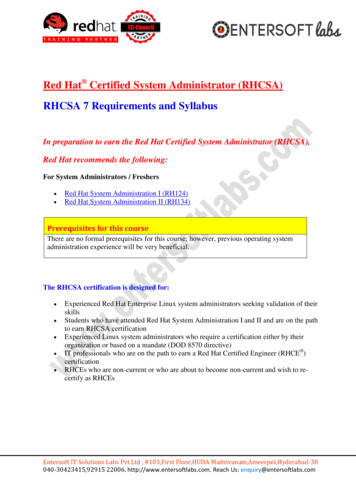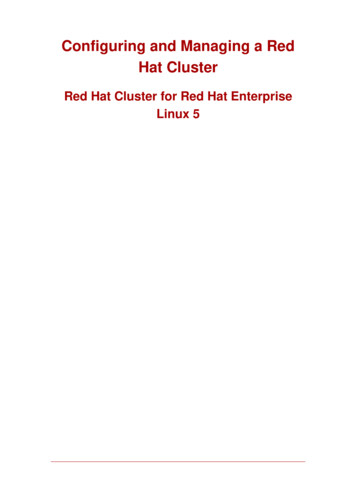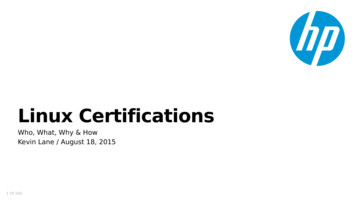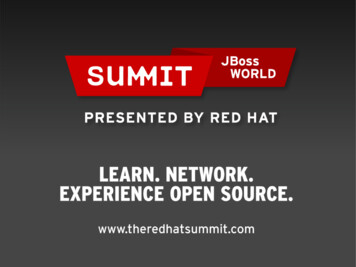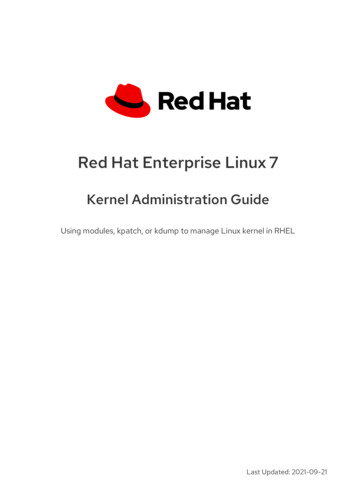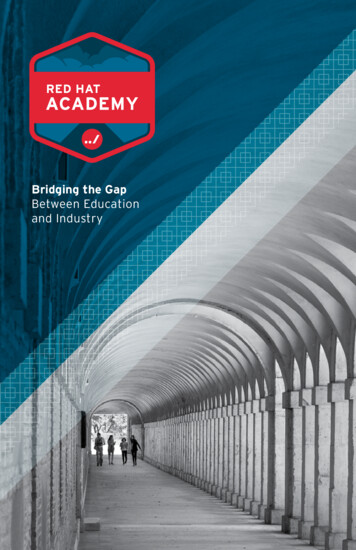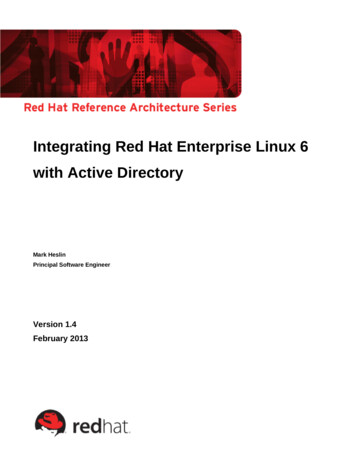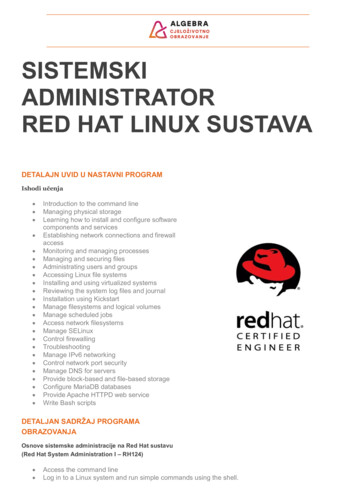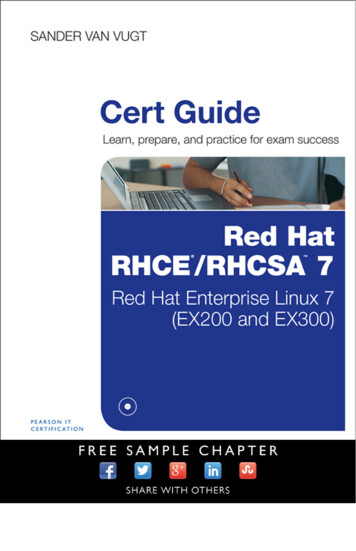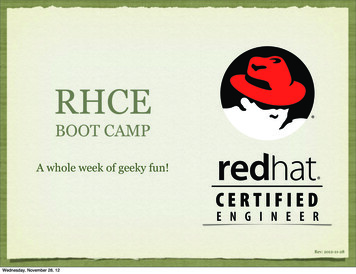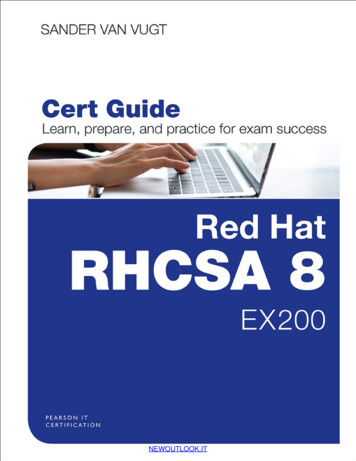
Transcription
NEWOUTLOOK.IT
Contents1. Cover Page2. About This eBook3. Title Page4. Copyright Page5. Contents at a Glance6. Table of Contents7. About the Author8. Dedication9. Acknowledgments10. About the Technical Reviewer11. We Want to Hear from Y ou!12. Reader Services13. Introduction1. Goals and Methods2. Who Should Read This Book?3. How This Book Is Organized4. How to Use This Book5. Other Features6. Exam Objective to Chapter Mapping7. Where Are the Companion Content Files?14. Figure Credits15. Part I: Performing Basic System Management TasksNEWOUTLOOK.IT
1. Chapter 1. Installing Red Hat Enterprise Linux1. “Do I Know This Already?” Quiz2. Foundation Topics3. Preparing to Install Red Hat Enterprise Linux4. Performing a Manual Installation5. Summary6. Exam Preparation Tasks7. Review All Key Topics8. Define Key Terms9. Review Questions10. End-of-Chapter .NEWOUTLOOK.IT
About This eBookePUB is an open, industry-standard format foreBooks. However, support of ePUB and its manyfeatures varies across reading devices and applications.Use your device or app settings to customize thepresentation to your liking. Settings that you cancustomize often include font, font size, single or doublecolumn, landscape or portrait mode, and figures thatyou can click or tap to enlarge. For additionalinformation about the settings and features on yourreading device or app, visit the device manufacturer’sWeb site.Many titles include programming code orconfiguration examples. To optimize the presentation ofthese elements, view the eBook in single-column,landscape mode and adjust the font size to the smallestsetting. .NEWOUTLOOK.IT
Red Hat RHCSA 8 CertGuideEX200Sander van VugtNEWOUTLOOK.IT
Red Hat RHCSA 8 Cert Guide: EX200Copyright 2020 by Pearson Education, Inc.All rights reserved. No part of this book shall bereproduced, stored in a retrieval system, or transmittedby any means, electronic, mechanical, photocopying,recording, or otherwise, without written permissionfrom the publisher. No patent liability is assumed withrespect to the use of the information contained herein.Although every precaution has been taken in thepreparation of this book, the publisher and authorassume no responsibility for errors or omissions. Nor isany liability assumed for damages resulting from theuse of the information contained herein.ISBN-13: 978-0-13-593813-3ISBN-10: 0-13-593813-9Library of Congress Control Number: 2019948460NEWOUTLOOK.IT
Contents at a GlanceIntroductionPart I: Performing Basic System ManagementTasksCHAPTER 1 Installing Red Hat EnterpriseLinuxCHAPTER 2 Using Essential ToolsCHAPTER 3 Essential File ManagementToolsCHAPTER 4 Working with Text FilesCHAPTER 5 Connecting to Red HatEnterprise Linux 8CHAPTER 6 User and Group ManagementCHAPTER 7 Permissions ManagementCHAPTER 8 Configuring NetworkingPart II: Operating Running SystemsCHAPTER 9 Managing SoftwareNEWOUTLOOK.IT
CHAPTER 10 Managing ProcessesCHAPTER 11 Working with SystemdCHAPTER 12 Scheduling TasksCHAPTER 13 Configuring LoggingCHAPTER 14 Managing StorageCHAPTER 15 Managing Advanced StoragePart III: Performing Advanced SystemAdministration TasksCHAPTER 16 Basic Kernel ManagementCHAPTER 17 Managing .NEWOUTLOOK.IT
Table of ContentsIntroductionPart I: Performing Basic System ManagementTasksChapter 1 Installing Red Hat EnterpriseLinux“Do I Know This Already?” QuizFoundation TopicsPreparing to Install Red Hat EnterpriseLinuxWhat Is Red Hat Enterprise Linux 8Server?Getting the SoftwareUsing Red Hat Enterprise LinuxUsing CentOSOther DistributionsUnderstanding Access to RepositoriesSetup RequirementsCert Guide Environment DescriptionNEWOUTLOOK.IT
Performing a Manual InstallationSummaryExam Preparation TasksReview QuestionsEnd-of-Chapter LabChapter 2 Using Essential Tools“Do I Know This Already?” QuizFoundation TopicsBasic Shell SkillsUnderstanding CommandsExecuting CommandsI/O RedirectionUsing PipesHistoryBash CompletionEditing Files with .NEWOUTLOOK.IT
About the AuthorSander van Vugt is an independent Linux trainer,author, and consultant living in the Netherlands. Sanderis the author of the best-selling Red Hat CertifiedSystem Administrator (RHCSA) Complete Video Courseand the Red Hat Certified Engineer (RHCE) CompleteVideo Course. He has also written numerous booksabout different Linux-related topics and many articlesfor Linux publications around the world. Sander hasbeen teaching Red Hat, Linux , and LFCS classes since1994. As a consultant, he specializes in Linux highavailability solutions and performance optimization.You can find more information about Sander on hiswebsite at http://www.sandervanvugt.com.For more information about RHCSA certification andadditional resources, .NEWOUTLOOK.IT
DedicationThis book is dedicated to my family: Florence, Franck,and Alex. Together we’ve made great accomplishmentsover the past year.NEWOUTLOOK.IT
AcknowledgmentsThis book could not have been written without the helpof all the people who contributed to it. I want to thankthe people at Pearson, Denise Lincoln and Ellie Bru inparticular. We’ve worked a lot together over the years,and this book is another milestone on our road tosuccess!NEWOUTLOOK.IT
About the TechnicalReviewerWilliam “Bo” Rothwell, at the impressionable age of14, crossed paths with a TRS-80 Micro ComputerSystem (affectionately known as a Trash 80). Soon after,the adults responsible for Bo made the mistake ofleaving him alone with the TRS-80. He immediatelydismantled it and held his first computer class, showinghis friends what made this “computer thing” work.Since this experience, Bo’s passion for understandinghow computers work and sharing this knowledge withothers has resulted in a rewarding career in IT training.His experience includes Linux, Unix, IT security,DevOps, and programming languages such as Perl,Python, Tcl, and Bash. Bo is the founder and leadinstructor of One Course Source, an IT training .NEWOUTLOOK.IT
We Want to Hear from You!As the reader of this book, you are our most importantcritic and commentator. We value your opinion andwant to know what we’re doing right, what we could dobetter, what areas you’d like to see us publish in, andany other words of wisdom you’re willing to pass ourway.We welcome your comments. You can email or write tolet us know what you did or didn’t like about this book—as well as what we can do to make our books better.Please note that we cannot help you with technicalproblems related to the topic of this book.When you write, please be sure to include this book’stitle and author as well as your name and email address.We will carefully review your comments and share themwith the author and editors who .NEWOUTLOOK.IT
Reader ServicesRegister your copy of Red Hat RHCSA 8 Cert Guide atwww.pearsonitcertification.com for convenient access todownloads, updates, and corrections as they becomeavailable. To start the registration process, go towww.pearsonitcertification.com/register and log in orcreate an account*. Enter the product ISBN9780135938133 and click Submit. When the process iscomplete, you will find any available bonus contentunder Registered Products.*Be sure to check the box that y ou would like to hear from us to receiv e exclusiv ediscounts on future editions of this product.NEWOUTLOOK.IT
IntroductionWelcome to the Red Hat RHCSA 8 Cert Guide. The RedHat exams are some of the toughest in the business, andthis guide will be an essential tool in helping youprepare to take the Red Hat Certified SystemAdministrator (RHCSA) exam.As an instructor with more than 20 years of experienceteaching Red Hat Enterprise Linux, I have taken theRHCSA exam (and the RHCE exam) numerous times sothat I can keep current on the progression of the exam,what is new, and what is different. I share myknowledge with you in this comprehensive Cert Guideso that you get the guidance you need to pass theRHCSA exam.The RHCSA exam was recently updated for Red HatEnterprise Linux 8. This book contains all you need toknow to pass the RHCSA exam. As .NEWOUTLOOK.IT
Figure CreditsChapter opener images by Charlie Edwards/Photodisc/Getty ImagesFigures 1-1 through 1-15 2019 Red Hat, IncFigures 2-1 and 2-2 2019 Red Hat, IncFigures 5-1 and 5-2 2019 Red Hat, IncFigures 8-1 through 8-5 2019 Red Hat, IncFigure 10-1 2019 Red Hat, IncFigures 18-1 through 18-5 2019 Red Hat, IncNEWOUTLOOK.IT
Part I: Performing BasicSystem ManagementTasksNEWOUTLOOK.IT
Chapter 1. Installing Red HatEnterprise LinuxThe following topics are covered in this chapter:Preparing to Install Red Hat Enterprise LinuxPerforming a Manual InstallationThis chapter covers no exam objectives.To learn how to work with Red Hat Enterprise Linux asan administrator, you first need to install it. Thischapter teaches you how to set up an environment inwhich you can perform all exercises in this book.On the RHCSA exam, you do not need to install Red HatEnterprise Linux. However, because you need to installan environment that allows you to test all itemsNEWOUTLOOK.IT
discussed in this book, you start by installing Red HatEnterprise .NEWOUTLOOK.IT
Chapter 2. Using EssentialToolsThe following topics are covered in this chapter:Basic Shell SkillsEditing Files with vimUnderstanding the Shell EnvironmentFinding HelpThe following RHCSA exam objectives are covered in this chapter:Use input-output redirection ( , , , 2 , etc.)Create and edit text filesLocate, read, and use system documentation including man, info,and files in /usr/share/docThis chapter is dedicated to coverage of the basic LinuxNEWOUTLOOK.IT
skills that everyone should have before attempting totake the RHCSA exam.“DO I KNOW THIS ALREADY?”QUIZThe “Do I Know This Already?” quiz allows you to assesswhether you should .NEWOUTLOOK.IT
Chapter 3. Essential FileManagement ToolsThis chapter covers the following subjects:Working with the File System HierarchyManaging FilesUsing LinksWorking with Archives and Compressed FilesThe following RHCSA exam objectives are covered in this chapter:Create, delete, copy, and move files and directoriesArchive, compress, unpack, and uncompress files using tar, star,gzip, and bzip2Create hard and soft linksLinux is a file-oriented operating system. That meansNEWOUTLOOK.IT
that many things an administrator has to do on Linuxcan be traced down to managing files on the Linuxoperating system. Also, when using hardware devices,files are involved. .NEWOUTLOOK.IT
Chapter 4. Working withText FilesThe following topics are covered in this chapter:Using Common Text File–Related ToolsA Primer to Using Regular ExpressionsUsing grep to Analyze TextWorking with Other Useful Text Processing UtilitiesThe following RHCSA exam objectives are covered in this chapter:Use grep and regular expressions to analyze textCreate and edit text filesSince the early days of UNIX, working with text files hasbeen an important administrator skill. Even on modernNEWOUTLOOK.IT
Linux versions such as Red Hat Enterprise Linux 8,working with text files is still an important skill. Byapplying the correct tools, you’ll easily find .NEWOUTLOOK.IT
Chapter 5. Connecting toRed Hat Enterprise Linux 8The following topics are covered in this chapter:Working on Local ConsolesUsing SSH and Related UtilitiesThe following RHCSA exam objectives are covered in this chapter:Access remote systems using SSHLog in and switch users in multiuser targetsBoot, reboot, and shut down a system normallySecurely transfer files between systemsConfigure key-based authentication for SSHYou have already learned how to log in on Linux from aNEWOUTLOOK.IT
graphical environment. In this chapter, you learn aboutsome other methods to access a Linux shell and startworking. You learn how to work from local consoles .NEWOUTLOOK.IT
Chapter 6. User and GroupManagementThe following topics are covered in this chapter:Different User TypesCreating and Managing User AccountsCreating and Managing Group AccountsThe following RHCSA exam objectives are covered in this chapter:Create, delete, and modify local user accountsChange passwords and adjust password aging for local useraccountsCreate, delete, and modify local groups and group membershipsConfigure superuser accessOn a Linux system, a wide variety of processes areNEWOUTLOOK.ITTechnet24
normally being used. These processes need access tospecific resources on the Linux system. To determinehow these resources can be accessed, a .NEWOUTLOOK.IT
Chapter 7. PermissionsManagementThe following topics are covered in this chapter:Managing File OwnershipManaging Basic PermissionsManaging Advanced PermissionsManaging ACLsSetting Default Permissions with umaskWorking with User-Extended AttributesThe following RHCSA exam objectives are covered in this chapter:List, set, and change standard ugo/rwx permissionsCreate and configure set-GID directories for collaborationCreate and manage access control listsNEWOUTLOOK.ITTechnet24
Diagnose and correct file permission problemsTo get access to files on Linux, permissions are used.These permissions are assigned to three entities: the fileowner, the group .NEWOUTLOOK.IT
Chapter 8. ConfiguringNetworkingThis chapter covers the following subjects:Networking FundamentalsManaging Network Addresses and InterfacesValidating Network ConfigurationManaging Network Configuration with nmtui and nmcliThe following RHCSA exam objectives are covered:Configure IPv4 and IPv6 addressesConfigure hostname resolutionNetworking is one of the most essential items on amodern server. On RHEL 8, networking is managed byNEWOUTLOOK.ITTechnet24
the NetworkManager service, and with the release ofRHEL 7, some completely new tools were introduced tohelp manage networks. If you have already worked withnetworking on RHEL 6 and older, you will .NEWOUTLOOK.IT
Part II: Operating RunningSystemsNEWOUTLOOK.ITTechnet24
Chapter 9. ManagingSoftwareThe following topics are covered in this chapter:Managing Software Packages with Y UMUsing yumManaging Package Module StreamsManaging Software Packages with RPMThe following RHCSA exam objectives are covered in this chapter:Install and update software packages from Red Hat Network, aremote repository, or from the local file systemWork with package module streamsManaging software packages is an important task for anadministrator of Red Hat Enterprise Linux. In thisNEWOUTLOOK.IT
chapter, you learn how to manage software packagesfrom the command line by using the yum utility. Youalso learn which role repositories .NEWOUTLOOK.ITTechnet24
Chapter 10. ManagingProcessesThe following topics are covered in this chapter:Introduction to Process ManagementManaging Shell JobsUsing Common Command-Line Tools for Process ManagementUsing top to Manage ProcessesUsing tuned to Optimize PerformanceThe following RHCSA exam objectives are covered in this chapter:Identify CPU/memory-intensive processes and kill processesAdjust process schedulingProcess management is an important task for a LinuxNEWOUTLOOK.IT
administrator. In this chapter, you learn what you needto know to manage processes from a perspective of dailyoperation of a server. You’ll learn how to work withshell jobs and generic .NEWOUTLOOK.ITTechnet24
Chapter 11. Working withSystemdThe following topics are covered in this chapter:Understanding SystemdManaging Units Through SystemdThe following RHCSA exam objective is covered in this chapter:Start and stop services and configure services to start automaticallyat bootIn this chapter, you’ll learn about Systemd, which is thesystem and service manager used on RHEL 8. You’llread about all the things that Systemd can do, and onceyou have a good general understanding, you’ll learn howto work with Systemd services. Systemd is also involvedNEWOUTLOOK.IT
in booting your system in a desired state, which is calleda target. That topic is covered .NEWOUTLOOK.ITTechnet24
Chapter 12. SchedulingTasksThe following topics are covered in this chapter:Configuring Cron to Automate Recurring TasksConfiguring At to Schedule Future TasksThe following RHCSA exam objective is covered in this chapter:Schedule tasks using at and cronOn a Linux server it is important that certain tasks runat certain times. This can be done by using the At andCron services, which can be configured to run tasks inthe future. The At service is for executing future tasksonce only, and the Cron service is for recurring regulartasks. In this chapter you learn how to configure both.NEWOUTLOOK.IT
“DO I KNOW THIS ALREADY?”QUIZThe “Do I Know .NEWOUTLOOK.ITTechnet24
Chapter 13. ConfiguringLoggingThe following topics are covered in this chapter:Understanding System LoggingConfiguring rsyslogdRotating Log FilesWorking with journaldThe following RHCSA exam objectives are covered in this chapter:Locate and interpret system log files and journalsPreserve system journalsAnalyzing log files is an important system administratortask. If anything goes wrong on a Linux system, theNEWOUTLOOK.IT
answer is often in the log files. On RHEL 8, twodifferent log systems are used side by side, and it isimportant to know which information can be foundwhere. This chapter teaches you all about it. You learnhow to read .NEWOUTLOOK.ITTechnet24
Chapter 14. ManagingStorageThe following topics are covered in this chapter:Understanding MBR and GPT PartitionsManaging Partitions and File SystemsMounting File SystemsThe following RHCSA exam objectives are covered in this chapter:List, create, delete partitions on MBR and GPT disksConfigure systems to mount file systems at boot by universallyunique ID (UUID) or labelAdd new partitions and logical volumes, and swap to a systemnondestructivelyCreate, mount, unmount, and use vfat, ext4, and xfs file systemsNEWOUTLOOK.IT
Working with storage is an important task for a Linuxadministrator. In this chapter, you acquire the first setof essential .NEWOUTLOOK.ITTechnet24
Chapter 15. ManagingAdvanced StorageThe following topics are covered in this chapter:Understanding LVMCreating LVM Logical VolumesResizing LVM Logical VolumesConfiguring StratisConfiguring VDOThe following RHCSA exam objectives are covered in this chapter:Create and remove physical volumesAssign physical volumes to volume groupsCreate and delete logical volumesExtend existing logical volumesNEWOUTLOOK.IT
Configure disk compressionManage layered storageIn Chapter 14, “Managing Storage,” you learned how tomanage partitions on a hard disk. Creating multiplepartitions on a disk is useful because it enables you tokeep different data types .NEWOUTLOOK.ITTechnet24
Part III: PerformingAdvanced SystemAdministration TasksNEWOUTLOOK.IT
Chapter 16. Basic KernelManagementThe following topics are covered in this chapter:Understanding the Role of the Linux KernelWorking with Kernel ModulesUpgrading the Linux KernelThe Linux kernel is the heart of the Linux operating system. Ittakes care of many things, including hardware management. Inthis chapter, you learn all you need to know about the Linuxkernel from an RHCSA perspective. In fact, you even learn a bitmore. This chapter includes information about topics that are noton the current list of RHCSA objectives. I think it is good to knowabout these topics anyway. Any serious Linux administratorshould be able to .NEWOUTLOOK.ITTechnet24
NEWOUTLOOK.IT
Chapter 17. Managing andUnderstanding the BootProcedureThe following topics are covered in this chapter:Managing Systemd TargetsWorking with GRUB 2The following RHCSA exam objectives are covered in this chapter:Configure systems to boot into a specific target automaticallyModify the system bootloaderIn this chapter, you learn how the boot procedure onRed Hat Enterprise Linux is organized. In the first partof this chapter, you learn about Systemd targets andNEWOUTLOOK.ITTechnet24
how you can use them to boot your Linux system into aspecific state. The second part of this chapter discussesGRUB2 and how to apply changes to the GRUB 2 bootloader. Troubleshooting .NEWOUTLOOK.IT
Chapter 18. EssentialTroubleshooting SkillsThe following topics are covered in this chapter:Understanding the RHEL 8 Boot ProcedurePassing Kernel Boot ArgumentsUsing a Rescue DiskFixing Common IssuesRecovering Access to a Virtual MachineThe following RHCSA exam objectives arecovered in this chapter:Boot systems into different targets manuallyInterrupt the boot process in order to gain access to a systemNEWOUTLOOK.ITTechnet24
In Chapter 17, “Managing and Understanding the BootProcedure,” you learned how a RHEL 8 server boots andwhich role the boot loader GRUB 2 and Systemd play inthat process. In this chapter, you learn what you can dowhen common .NEWOUTLOOK.IT
Chapter 19. An Introductionto Bash Shell ScriptingThe following topics are covered in this chapter:Understanding Shell Scripting Core ElementsUsing Variables and InputUsing Conditional LoopsShell scripting is a science all by itself. You do not learnabout all the nuts and bolts related to this science in thischapter. Instead, you learn how to apply basic shellscripting elements, which allows you to write a simpleshell script and analyze what is happening in a shellscript.“DO I KNOW THIS ALREADY?”NEWOUTLOOK.ITTechnet24
QUIZThe “Do I Know This Already?” quiz allows you to assesswhether you should read this entire chapter thoroughlyor jump to the “Exam .NEWOUTLOOK.IT
Part IV: Managing NetworkServicesNEWOUTLOOK.ITTechnet24
Chapter 20. ConfiguringSSHThe following topics are covered in this chapter:Hardening the SSH ServerUsing Other Useful sshd OptionsConfiguring Key-Based Authentication with PassphrasesThe following RHCSA exam objective is coveredin this chapter:Configure key-based authentication for SSHSecure Shell (SSH) is among the most importantutilities that system administrators use. In Chapter 5,“Connecting to Red Hat Enterprise Linux 8,” youNEWOUTLOOK.IT
learned how to use SSH to connect to a server using apassword or key-based authentication. In this chapter,you learn about some of the more advancedconfiguration settings.“DO I KNOW THIS ALREADY?” .NEWOUTLOOK.ITTechnet24
Chapter 21. ManagingApache HTTP ServicesThe following topics are covered in this chapter:Configuring a Basic Apache ServerUnderstanding Apache Configuration FilesCreating Apache Virtual HostsThe following RHCSA exam objectives are covered in this chapter:No RHCSA exam objectives relate directly to Apache, but minimalApache knowledge is required to master the SELinux-relatedobjectives.This is the only chapter in this book that discusses asubject that is not even listed in the RHCSA objectives.However, for a Red Hat server administrator, it isNEWOUTLOOK.IT
important to know how to deal with the Apache webservice. In following chapters, you .NEWOUTLOOK.ITTechnet24
Chapter 22. ManagingSELinuxThe following topics are covered in this chapter:Understanding SELinux Working ModesUnderstanding Context Settings and the PolicyRestoring Default File ContextsUsing Boolean Settings to Modify SELinux SettingsDiagnosing and Addressing SELinux Policy ViolationsThe following RHCSA exam objectives arecovered in this chapter:Set enforcing and permissive modes for SELinuxList and identify SELinux file and process contextRestore default file contextsNEWOUTLOOK.IT
Use boolean settings to modify system SELinux settingsDiagnose and address routine SELinux policy violationsSince the earliest days of Linux, file permissions .NEWOUTLOOK.ITTechnet24
Chapter 23. Configuring aFirewallThe following topics are covered in this chapter:Understanding Linux FirewallingWorking with FirewalldThe following RHCSA exam objective is coveredin this chapter:Restrict network access using firewall-cmd/firewallIf a server is connected to the Internet, it needs to beprotected against unauthorized access. SELinux is onepart of this protection as discussed in Chapter 22,“Managing SELinux”), and a firewall is the second part.NEWOUTLOOK.IT
The Linux kernel implements firewalling via thenetfilter framework. To configure which packets areallowed and which are not, Firewalld is the defaultsolution in RHEL 8. .NEWOUTLOOK.ITTechnet24
Chapter 24. AccessingNetwork StorageThe following topics are covered in this chapter:Using NFS ServicesUsing CIFS ServicesMounting Remote File Systems Through fstabUsing Automount to Mount Remote File SystemsThe following RHCSA exam objective is coveredin this chapter:Mount and unmount network file systems using NFSThe RHCSA exam requires that you know how to accessnetwork storage. This encompasses different topics.NEWOUTLOOK.IT
We’ll discuss accessing network storage that has beenprovided through CIFS and NFS. You’ll learn how tomount network storage through the fstab file, as well ashow to automatically mount this storage usingautomount .NEWOUTLOOK.ITTechnet24
Chapter 25. ConfiguringTime ServicesThe following topics are covered in this chapter:Understanding Local TimeUsing Network Time ProtocolManaging Time on Red Hat Enterprise LinuxThe following RHCSA exam objective is coveredin this chapter:Configure time service clientsAn increasing number of services offered through Linuxservers depend on the correct configuration of time onthe server. Think of services such as databaseNEWOUTLOOK.IT
synchronization, Kerberos authentication, and more. Inthis chapter, you learn how time is configured on aLinux server.“DO I KNOW THIS ALREADY?”QUIZThe “Do I Know This Already?” quiz allows you to assesswhether .NEWOUTLOOK.ITTechnet24
Chapter 26. FinalPreparationCongratulations! You made it through the book, andnow it’s time to finish getting ready for the RHCSAexam. This chapter helps you get ready to take and passthe exam. In this chapter, you learn more about theexam process and how to register for the exam. You alsoget some useful tips that will help you avoid somecommon pitfalls while taking the exam.GENERAL TIPSIn this section, you get some general tips about theexam. You learn how to verify your exam readiness, howto register for the exam, and what to do on the exam.Verifying Your ReadinessOnly register for the exam when you think that you areready to pass it. This book contains a lot of material tohelp you verify your exam readiness. To start with, .NEWOUTLOOK.IT
Chapter 27. Theoretical PreAssessment ExamThis chapter provides an RHCSA theoretical preassessment exam to help you determine what you knowand what you do not know. This theoretical exam isprovided so that you can assess your skills anddetermine the best route forward for studying for theexam.The RHCSA exam is a 100% practical exam. Therefore,you need to work on actual configuration tasks, and youmust deliver a working configuration at the end of theexam. Therefore, passing this practical exam requiresthat you have a working knowledge of RHEL 8. Thischapter helps you check whether you ha
Welcome to the Red Hat RHCSA 8 Cert Guide. The Red Hat exams are some of the toughest in the business, and this guide will be an essential tool in helping you prepare to take the Red Hat Certified System Administrator (RHCSA) exam. As an instructor with more than 20 years of exper
